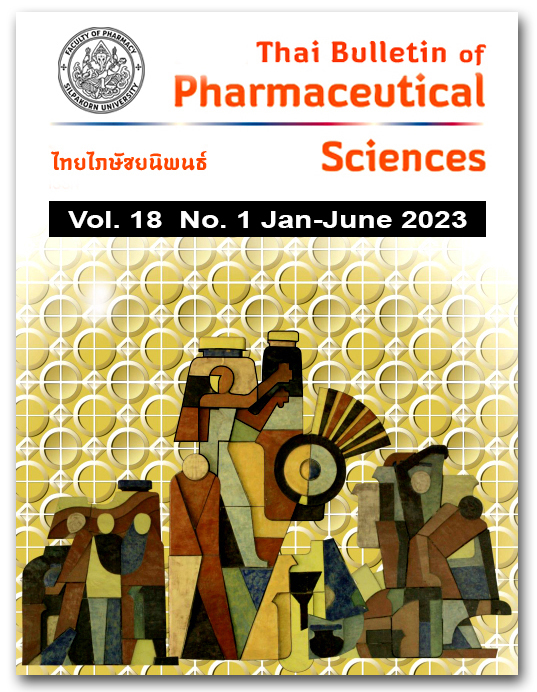OPTIMIZATION AND EVALUATION OF MICROEMULSIONS CONTAINING GRAPE SEED OIL
DOI:
https://doi.org/10.69598/tbps.18.1.87-95Keywords:
grape seed oil, microemulsion, polysorbate 80, Cetiol®, HE, , antioxidant activityAbstract
Grape seed oil, obtained from grape seeds (Vitis Vinifera L.), is used in cosmetic products. It demonstrates antifungal, antioxidant, anti-inflammation, and antibacterial activities. Microemulsions are a type of drug delivery system that has thermodynamic stability. Grape seed oil-loaded microemulsions were prepared by mixing water, oil, surfactant, and co-surfactant in an appropriate ratio. The objectives of this study were to develop grape seed oil-loaded microemulsions and to investigate the effects of surfactants (polysorbate 80 and polysorbate 20) and co-surfactants (ethanol, isopropyl alcohol, Cetiol® HE, and glycerin) on the physicochemical properties of the microemulsions. The stability was studied for 30 days at room temperature and protected from light. In addition, the antioxidant activity of grape seed oil and microemulsion formulations was analyzed. From the pseudo-ternary phase diagram, polysorbate 80, and Cetiol® HE at a ratio of 1:2 showed the largest microemulsion area. The amount of the loaded-grape seed oil and surfactant mixtures were 5-15% and 75-85%, respectively. All formulations were transparent light-yellow emulsions showing good thermodynamic stability. Moreover, surface charges, conductivity, pH, and viscosity were desirable. After the 30 day-stability tests, all microemulsion formulations presented good thermodynamic stability with no apparent changes observed. The antioxidant activity increased as grape seed oil was added in greater quantities. Despite the fact that the size of the particle was greater than 300 nm and the PDI value was high, the findings indicated that a microemulsion system containing grape seed oil, polysorbate 80, and Cetiol® HE could be utilized with good antioxidant activity.
References
Kapcsándi V, Hanczné LE, Sik B, Linka LÁ, Székelyhidi R. Characterization of fatty acid, antioxidant, and polyphenol content of grape seed oil from different Vitis vinifera L. varieties. OCL. 2021;28:1-6.
Martin ME, Grao-Cruces E, Millan-Linares MC, Montserrat-de la Paz S. Grape (Vitis vinifera L.) seed oil: a functional food from the winemaking industry. Foods. 2020;9(10):1-20.
Shivananda Nayak B, Dan Ramdath D, Marshall JR, Isitor G, Xue S, Shi J. Wound-healing properties of the oils of Vitis vinifera and Vaccinium macrocarpon. Phytother Res. 2011;25(8):1201-8.
Robinson BH. Colloid chemistry: Applications of microemulsions. Nature. 1986;320:309.
Noushine S, Daniel B, Olivier A, Jacques M. Spontaneous emulsification: relation to microemulsion phase behaviour. Colloids Surf A Physicochem Eng Asp. 1999;147:375-80.
Yang J, Xu H, Wu S, Ju B, Zhu D, Yan Y, et al. Preparation and evaluation of microemulsionbased transdermal delivery of Cistanche tubulosa phenylethanoid glycosides. Mol Med Rep. 2017;15(3):1109-16.
Berkman M, Güleç K. Pseudo ternary phase diagrams: a practical approach for the area and centroid calculation of stable microemulsion regions. Istanbul J Pharm. 2021;51(1):42-9.
Panomsuk S, Phonggasor Y, Thongnasarn N, Duangkaew R, Vichitsawangwong S, Opanosopit P, et al. Formulation and characterization of tea tree oil microemulsions. In: Putalun W, Sangthong B, editors. HTM 2017. Proceedings of the 2nd International Conference on Herbal and Traditional Medicine; 2017 Jan 25-27; Bangkok, Thailand. Khon Kaen: Khon Kaen University Printing House; 2017. p. 321-7.
Panomsuk S, Porkar N, Meerasen P, Kunrattanaporn N, Satiraphan M. Development and physico-chemical evaluations of clove oil microemulsions. Key Eng Mater. 2020;859:62-7.
Sumaiyah M, Leisyah B. The effect of antioxidant of grapeseed oil as skin anti-aging in nanoemulsion and emulsion preparations. Rasayan J Chem. 2019;12(03):1185-94.
McClements DJ. Nanoemulsions versus microemulsions: terminology, differences, and similarities. Soft Matter. 2012;8(6):1719-29.
Sheth T, Seshadri S, Prileszky T, Helgeson ME. Multiple nanoemulsions. Nat Rev Mater. 2020;5(3):214-28.
Muhammad Asri Abd Sisa, Rusli Daik, Ramli S. Study on the effect of oil phase and co-surfactant on microemulsion systems. Malaysian J Anal Sc. 2017;21(6):1409-16.
Sarheed O, Dibi M, Ramesh K. Studies on the effect of oil and surfactant on the formation of alginate-based O/W lidocaine nanocarriers using nanoemulsion template. Pharmaceutics. 2020;12(1223):1-21.
Leung R, Shah DO. Solubilization and phase equilibria of water-in-oil microemulsions: II. Effects of alcohols, oils, and salinity on single-chain surfactant systems. J Colloid Interface Sci. 1987;120(2):330-44.
Cho YH, Kim S, Bae EK, Mok CK, Park J. Formulation of a cosurfactant-free O/W microemulsion using nonionic surfactant mixtures. J Food Sci. 2008;73(3):E115-21.
Talegaonkar S, Azeem A, Ahmad FJ, Khar RK, Pathan SA, Khan ZI. Microemulsions: a novel approach to enhanced drug delivery. Recent Pat Drug Deliv Formul. 2008;2(3):238-57.
Leong WF, Man YBC, Lai OM, Long K, Misran M, Tan CP. Optimization of processing parameters for the preparation of phytosterol microemulsions by the solvent displacement method. J Agric Food Chem. 2009;57:8426-33.
Baroli B, López-Quintela MA, Delgado-Charro MB, Fadda AM, Blanco-Méndez J. Microemulsions for topical delivery of 8-methoxsalen. J Control Release. 2000;69(1):209-18.
Park ES, Cui Y, Yun BJ, Ko IJ, Chi SC. Transdermal delivery of piroxicam using microemulsions. Arch Pharm Res. 2005;28(2):243-8.
Garavaglia J, Markoski MM, Oliveira A, Marcadenti A. Grape seed oil compounds: biological and chemical actions for health. Nutr Metab Insights. 2016;9:59-64.
Downloads
Published
How to Cite
Issue
Section
License
All articles published and information contained in this journal such as text, graphics, logos and images is copyrighted by and proprietary to the Thai Bulletin of Pharmaceutical Sciences, and may not be reproduced in whole or in part by persons, organizations, or corporations other than the Thai Bulletin of Pharmaceutical Sciences and the authors without prior written permission.



